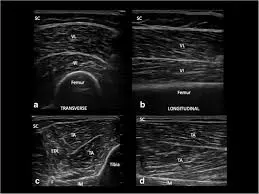Comment Interpréter les Ultrasons Musculaires : 3 Techniques Clés
L'ultrason musculaire est un outil de diagnostic précieux utilisé pour évaluer la santé et l'état des muscles. Ce guide explorera l'utilisation des ultrasons musculaires, ce qu'ils peuvent montrer et les méthodes d'interprétation des résultats.
Qu'est-ce que l'Ultrason Musculaire ?
L'ultrason musculaire est une technique d'imagerie non invasive qui utilise des ondes sonores pour visualiser les tissus musculaires, les tendons et les ligaments. C'est une modalité d'imagerie sûre, rentable et en temps réel utilisée pour diagnostiquer diverses conditions.

Que Peut Montrer un Ultrason Musculaire ?
- Blessures Musculaires : Détecte les déchirures, les entorses et les hématomes au sein des muscles.
- Problèmes de Tendons et de Ligaments : Visualise la tendinite, la tendinose et les entorses ou déchirures ligamentaires.
- Masse et Tumeurs : Identifie les croissances ou masses anormales dans les tissus mous.
- Collections Liquides : Détecte l'accumulation de liquide ou des kystes autour des muscles.
- Évaluation en Temps Réel : Permet une évaluation dynamique des mouvements et de la fonction musculaires.
- Procédures Guidées : Aide à guider les injections à l'aiguille ou les biopsies à des fins diagnostiques et thérapeutiques.
Pourquoi Pourriez-Vous Avoir Besoin d'un Ultrason Musculaire ?
- Douleur et Gonflement Musculaires : Pour évaluer la cause de l'inconfort, de l'inflammation ou du gonflement dans le tissu musculaire.
- Blessures Sportives : Utilisé pour diagnostiquer les blessures muscaires et tendineuses dues aux activités sportives.
- Masses de Tissus Mous : Pour évaluer toute grosseur ou bosse palpable sous la peau.
- Tendons Douloureux : Pour évaluer des conditions telles que la tendinopathie ou la ténosynovite.
- Injections Guidées : Pour une guidance précise lors de l'administration de médicaments ou de traitements ciblés.
- Évaluation Post-Chirurgicale : Pour surveiller la récupération et la guérison des tissus musculosquelettiques.
Comment Interpréter les Résultats d'Ultrason Musculaire
Interpréter les images d'ultrason musculaire nécessite de comprendre à la fois l'anatomie normale des muscles et les constatations pathologiques courantes. Voici trois façons d'aborder ce processus.
1. Utilisation de X-ray Interpreter
X-ray Interpreter propose une analyse pilotée par l'IA pour aider à l'interprétation des ultrasons :
- Inscription : Inscrivez-vous sur X-ray Interpreter pour utiliser notre IA pour l'analyse des ultrasons.
- Télécharger des Images : Téléchargez vos images d'ultrason musculaire sur la plateforme.
- Recevoir un Rapport : Examinez le rapport d'interprétation généré par l'IA.
- Consultation : Discutez toujours des résultats avec votre professionnel de santé.
Vérifiez notre guide de démarrage pour plus de détails.
2. Utilisation de ChatGPT Plus
ChatGPT Plus, alimenté par GPT-4V, peut également aider à analyser les images d'ultrason :
- Abonnement : Abonnez-vous à ChatGPT Plus pour des capacités avancées de l'IA.
- Télécharger des Images : Téléchargez vos images d'ultrason sur la plateforme.
- Demander une Analyse : Demandez à ChatGPT d'analyser les images d'ultrason.
- Examiner : Examinez l'interprétation fournie et confirmez l'exactitude avec un professionnel de santé.
Lisez plus dans notre blog sur l'utilisation de ChatGPT Plus pour l'interprétation des images médicales.
Alternativement, alors que plusieurs autres modèles d'IA avec des capacités visuelles émergent, vous pouvez également essayer d'autres modèles, tels que Grok par xAI, Claude par Anthropic, Gemini par Google Deepmind.
3. Comprendre les Bases Vous-Même
Apprendre les bases des ultrasons musculaires peut vous permettre de poser des questions plus éclairées à votre professionnel de santé.
- Apprendre l'Anatomie Musculaire : Familiarisez-vous avec l'anatomie musculaire de base et les structures tissulaires.
- Rechercher des Résultats Courants : Recherchez les résultats typiques des ultrasons musculaires et les présentations.
- Poser des Questions : Notez tous les termes inconnus et demandez des clarifications à votre médecin lors de votre suivi.
- Chercher des Conseils d'Experts : Confirmez toujours vos auto-interprétations avec un professionnel de santé qualifié.
Comparaison des Différentes Approches
Voici comment ces méthodes d'interprétation se comparent selon des critères clés :
| Critères | X-ray Interpreter | ChatGPT Plus | Auto-lecture |
|---|---|---|---|
| Précision | Élevée (basée sur l'IA)1 | Élevée (basée sur l'IA)1 | Variable (dépend de la compétence) |
| Facilité d'utilisation | Facile | Modérée | Difficile |
| Coût | À partir de 2,50 $ par image | 20 $ par mois | Gratuit (hors frais éducatifs) |
| Efficacité Temporelle | Rapide | Modérée à Rapide | Lent à Modéré |
| Courbe d'Apprentissage | Faible | Faible à Modérée | Élevée |
| Ressources Supplémentaires | Fournies | Partiellement Fournies (via OpenAI) | Auto-sourcées |
Chaque approche a ses avantages. L'IA fournit une analyse rapide et précise tandis qu'une compréhension de base aide à la communication patient-docteur.
Conclusion
L'ultrason musculaire est un outil puissant pour diagnostiquer les conditions musculaires et des tissus mous. Ce guide a fourni un aperçu des images qu'il produit et des façons dont vous pouvez améliorer votre compréhension, en utilisant l'IA ou des connaissances fondamentales.
En choisissant une méthode, gardez à l'esprit vos besoins spécifiques, votre niveau de compréhension et les ressources disponibles. Demandez confirmation des résultats à votre médecin et soyez conscient des normes de confidentialité.